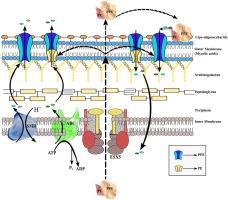International Journal of Medical Microbiology ( IF 4.1 ) Pub Date : 2021-03-09 , DOI: 10.1016/j.ijmm.2021.151495 Aquib Ehtram , Mohd Shariq , Sabeeha Ali , Neha Quadir , Javaid A. Sheikh , Faraz Ahmad , Tarina Sharma , Nasreen Z. Ehtesham , Seyed E. Hasnain

|
Permeation through bacterial cells for exchange or uptake of biomolecules and ions invariably depend upon the existence of pore-forming proteins (porins) in their outer membrane. Mycobacterium tuberculosis (M. tb) harbours one of the most rigid cell envelopes across bacterial genera and is devoid of the classical porins for solute transport across the cell membrane. Though canonical porins are incompatible with the evolution of permeability barrier, porin like activity has been reported from membrane preparations of pathogenic mycobacteria. This suggests a sophisticated transport mechanism that has been elusive until now, along with the protein family responsible for it. Recent evidence suggests that these slow-growing mycobacteria have co-opted some of PE/PPE family proteins as molecular transport channels, in place of porins, to facilitate uptake of nutrients required to thrive in the restrictive host environment. These reports advocate that PE/PPE proteins, due to their structural ability, have a potential role in importing small molecules to the cell's interior. This mechanism unveils how a successful pathogen overcomes its restrictive membrane's transport limitations for selective uptake of nutrients. If extrapolated to have a role in drug transport, these channels could help understand the emergence of drug resistance. Further, as these proteins are associated with the export of virulence factors, they can be exploited as novel drug targets. There remains, however, an interesting question that as the PE/PPE proteins can allow the 'import' of molecules from outside the cell, is the reverse transport also possible across the M. tb membrane. In this review, we have discussed recent evidence supporting PE/PPE's role as a specific transport channel for selective uptake of small molecule nutrients and, as possible molecular export machinery of M. tb. This newly discovered role as transmembrane channels demands further research on this enigmatic family of proteins to comprehend the pathomechanism of this very smart pathogen.
中文翻译:

目的论的共择结核分枝杆菌PE / PPE蛋白作为孔蛋白:角色在分子迁入和迁出
通过细菌细胞渗透以交换或吸收生物分子和离子始终取决于其外膜中成孔蛋白(porins)的存在。结核分枝杆菌(结核分枝杆菌)在细菌属中具有最坚硬的细胞包膜之一,并且没有用于溶质跨细胞膜转运的经典孔蛋白。尽管规范孔蛋白与渗透性屏障的发展不相容,但据报道,致病性分枝杆菌的膜制剂具有孔蛋白样活性。这表明至今为止还难以捉摸的复杂的运输机制,以及负责该机制的蛋白质家族。最近的证据表明,这些缓慢增长的分枝杆菌已替代了一部分PE / PPE家族蛋白作为分子转运通道,代替了孔蛋白,以促进在限制性宿主环境中壮成长所需的营养物质的吸收。这些报告主张,PE / PPE蛋白由于其结构能力,在将小分子导入细胞内部方面具有潜在作用。该机制揭示了成功的病原体如何克服其限制性膜对选择性吸收养分的运输限制。如果推断为在药物运输中起作用,则这些通道可以帮助了解耐药性的出现。此外,由于这些蛋白质与毒力因子的输出有关,因此可以将它们开发为新型药物靶标。然而,仍然存在一个有趣的问题,因为PE / PPE蛋白可以允许分子从细胞外“导入”,因此是否有可能在细胞内进行反向转运。如果推断为在药物运输中起作用,则这些通道可以帮助了解耐药性的出现。此外,由于这些蛋白质与毒力因子的输出有关,因此可以将它们开发为新型药物靶标。然而,仍然存在一个有趣的问题,因为PE / PPE蛋白可以允许分子从细胞外“导入”,因此是否有可能在细胞内进行反向转运。如果推断为在药物运输中起作用,则这些通道可以帮助了解耐药性的出现。此外,由于这些蛋白质与毒力因子的输出有关,因此可以将它们开发为新型药物靶标。然而,仍然存在一个有趣的问题,因为PE / PPE蛋白可以允许分子从细胞外“导入”,因此是否有可能在细胞内反向转运。结核分枝杆菌膜。在这篇综述中,我们讨论了最近的证据,这些证据支持PE / PPE作为选择性摄取小分子营养物以及可能的结核分枝杆菌分子出口机制的特定运输渠道的作用。这种新发现的跨膜通道作用要求对该神秘蛋白家族进行进一步研究,以了解这种非常聪明的病原体的致病机理。


























 京公网安备 11010802027423号
京公网安备 11010802027423号